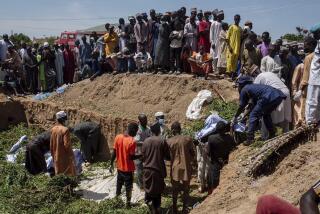‘The People Were Sleeping’ as Volcano Gas Killed 1,200 : 5 Nations Rush Aid to Cameroon
- Share via
YAOUNDE, Cameroon — At least 1,200 people were killed and 300 hospitalized when an underwater volcanic explosion unleashed deadly gases at Lake Nios in a remote area of northern Cameroon, President Paul Biya said today.
“The people were sleeping and heard a noise,” Biya told reporters. “The gases intoxicated them and they died.”
Biya said the leak has stopped but issued warnings for travelers to the area. He appeared with visiting Israeli Prime Minster Shimon Peres, who earlier described the explosion as “a great catastrophe.”
Biya said that the tragedy occurred Friday night as the victims slept in their homes on the lake shore and that the gas spread over a 10-mile radius around the town of Wum, 250 miles northwest of here.
4 Possible Gases
He said 300 survivors were being treated in hospitals for gas poisoning.
Biya said the type of gas that killed the villagers had not been determined. U.S. scientists said there were four possibilities: hydrogen sulfide, carbon dioxide and carbon monoxide or a combination of the three.
A government announcement Sunday night said the killer gas was hydrogen sulfide, but volcanic experts questioned the analysis.
Haroun Tazieff, France’s pre-eminent volcanologist, was quoted by the French press as saying hydrogen sulfide is light enough to dissipate quickly and has such a strong odor that people would be alerted and flee.
Tazieff said it is much more likely that a large quantity of colorless, odorless carbon monoxide, released from beneath the lake’s surface, hugged the ground, killing the villagers before they knew it.
Darrell Herd of the U.S. Geological Survey in Reston, Va., said hydrogen sulfide is usually only a minor component of volcanic gases. He speculated that the disaster might have been caused by either carbon monoxide or carbon dioxide.
37 Killed Earlier
Herd said that in 1984 a cloud of odorless carbon dioxide killed 37 people in the same area as the latest disaster. In 1984, the lethal gas had been trapped in sediment at the bottom of a lake and was released by a landslide or a small earth tremor, he said.
A doctor at the main hospital in Yaounde said the victims were poisoned by a mixture of gases, including hydrogen and sulfur. He said the symptoms were like being gassed by a kitchen stove: burning pains in the eyes and nose, coughing and signs of asphyxiation similar to strangulation.
The casualty figure seesawed throughout the day. At one point, an information minister said 2,000 had died. The official radio said that was a mistake and that 40 had died.
Rescue teams were initially blocked from reaching the scene because gas was detected in the air. The site is in a mountainous region with unpaved roads rendered nearly impassable in the current rainy season.
One report had said the whole population had been wiped out in a community around Nios. The toll from the natural toxic gas release puts the disaster on a par with the worst man-made gas accident in history, when more than 2,000 people died in Bhopal, India, from a methyl isocyanate leak in December, 1984.
‘A Frightful Sight’
Joseph Mokassa, top staff aide to the provincial governor in Bamenda, the provincial capital, said by telephone that he saw many dead but did not have precise figures.
“I went there on Saturday and it was such a frightful sight because so many people had lost their lives,” he said.
Peres arrived in Cameroon today and is expected to announce a resumption of diplomatic relations between the two nations. (Story, Page 2.) It was the first official visit to black Africa by an Israeli prime minister in more than 20 years.
He brought with him a 17-member Israeli medical team to assist local authorities. The United States, France, Britain and West Germany also sent rescue teams and other assistance.
More to Read
Sign up for Essential California
The most important California stories and recommendations in your inbox every morning.
You may occasionally receive promotional content from the Los Angeles Times.













